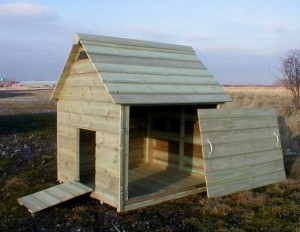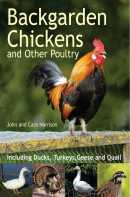Just like chickens kept in the garden, ducks are at risk from predator attacks such as foxes. Training ducks to go into a coop or house takes only a few nights and makes sure your new pets are warm and protected.
The Duck House
All ducks will need a warm safe night house. When building or buying a duck house you need to look out for the size of the pop hole, the height of the house and the ramp to the house. Make sure the house is sturdy and has good ventilation holes at the roof of the house.
Duck House Space
Large breeds such as Aylesburys need a good two-foot square area and the same in height. The medium breeds to large breeds such as Runners need the same height but about one and half foot square area.
Smaller ducks such as call ducks require the same size of housing as large breed chickens – about one-foot square per bird.
Larger Pop Hole Required for Duck Houses
Often pre-bought chicken coops can be used for ducks provided they have no perching bars restricting the floor space for the ducks. However, something to look out for is the size of the entrance or pop hole. Make sure your biggest duck can get in through the door as these are often designed for smaller birds and Runners and Aylesburys need that extra bit of width and height to get into their house at night.
Ramp
Ducks don’t usually fly up to the coop the same as chickens, being a ground nesting bird so a ramp will need to be provided so that they can access easily. This allows them to get in and out without injuring themselves.
Training Ducks
When you first get a new coop or house often the ducks will refuse to enter and will look concerned at the new building. If possible get them used to it being in the garden for a day or two before moving them into it. To train a duck to go up and down the ramp trail some food along it and watch them start running up and down without hesitation – I find tomatoes are the best way to get ducks to do what you want.
The same trick should be used at night to get them into the new house. Show the ducks a bowl of food and place it in the back of the house leaving a trail to it for a day or two. The ducks will soon be using the ramp and going to bed at dusk without any problems.
The Run
So much easier for the duck keeper than the chicken keeper! Flightless, large breed and clipped wing ducks are very easy to contain in an area of the garden. A two to three foot barrier will suffice. Make sure the run has at least two meters square for the birds to range in. A movable wooden and mesh run is a great idea as you can move the ducks around the garden letting them eat all the pests, but stopping them from damaging an area through over use.
Remember though that just because the ducks cant get out doesn’t mean the predators can’t get in –make sure your house and run are fox proof.
More on Keeping Ducks at Home in the Back Garden
- Best Duck Breeds for Home Back Garden Keepers
- Duck Housing – Accommodation and Enclosed Runs
- Ducks & Water – Do You Need a Pond?



